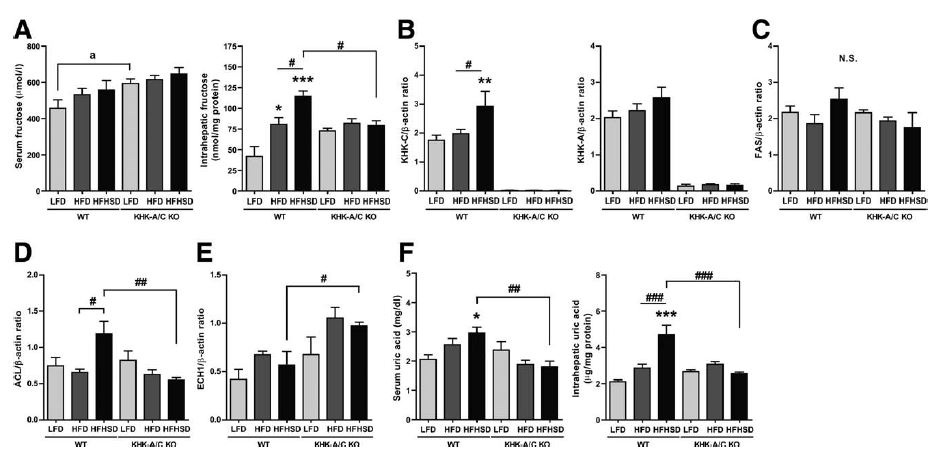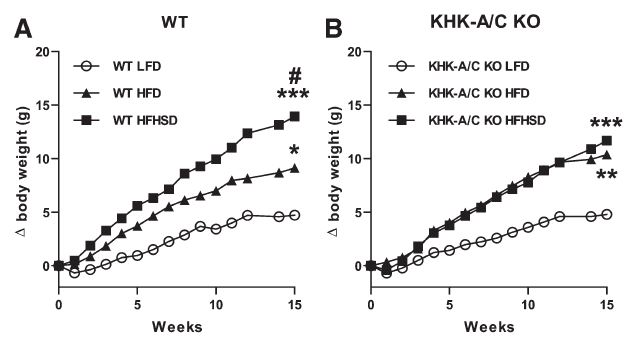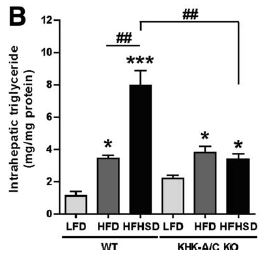High Fat + High Fructose = Bad Liver
The paper: Ishimoto, T. et al. (2013) High-fat and high-sucrose (western) diet induces steatohepatitis that is dependent on fructokinase. Hepatology. doi:10.1002/hep.26594
Subject areas: Physiology, Biochemistry, Health
Vocabulary:
metabolic syndrome – refers to a group of five risk factors that together significantly raise the risk of health problems like heart disease, stroke, and diabetes. The factors are (1) abdominal obesity, (2) high triglyceride (a type of fat) blood level, (3) low HDL (“good cholesterol”) level, (4) high blood pressure, and (5) high blood sugar. Metabolic syndrome is officially diagnosed if a patient has at least three of these factors.
fructose – a six-carbon sugar that has the same general chemical formula as glucose, which is the basic sugar that cells prefer to break down for energy; however, it has a different structure/shape, so it is not interchangeable with glucose and uses different enzymes to break it down. Table sugar, or sucrose is made of a fructose and a glucose bonded together.
—–
This article is a summary of a recent primary research paper intended for high school teachers to add to their general knowledge of current biological research, or to supplement their lessons by showing students the kinds of projects that current biological research addresses.
—–
Fructose, especially in the form of “high-fructose corn syrup” (HFCS), has been getting clobbered in the media over the last few years. Unfortunately, the media and advertisers do not always appreciate the chemistry involved, and we get dumb comparisons of “pure cane sugar” to high-fructose corn syrup. The fact is, cane sugar is sucrose, a disaccharide, or two simple sugars bonded together. When it is broken down after you eat it, the first breakdown is to turn it into equal amounts of glucose and fructose. As it turns out, “high-fructose” corn syrup is either 55% fructose (in sweetened drinks) or 42% fructose (in other sweetened products). So from a food nutrition point of view, they are essentially interchangeable. In fact, the article discussed here mentions the functional equivalence of giving experimental animals sucrose, fructose, or HFCS.
What they knew.
Work by other groups clearly demonstrate that when rats or other experimental animals are fed diets high in fructose, they are likely to develop hepatic steatosis, which is an overabundance of lipid (triglyceride) droplets in the liver. The condition is also known as fatty liver, and in humans, is associated with obesity, type 2 diabetes, and hypertension, among other issues. The accumulation of the lipids inside liver cells can affect normal liver function. The hepatic steatosis occurred whether the fructose source was sucrose, HFCS, or pure fructose.
Ishimoto et al have looked into the biochemical mechanism that leads from a high-fat and high-sucrose diet to development of steatohepatitis, which is essentially liver inflammation due to hepatic steatosis. Their working hypothesis was that the enzyme fructokinase, which is the first enzyme in the metabolic pathway for fructose breakdown, is also the mechanism that leads to steatohepatitis.
What they did.
There are two kinds of fructokinase (also known as ketohexokinase): fructokinase A and fructokinase C. Type C is the major form in the liver. Ishimoto and colleagues made transgenic mice in which the genes for fructokinase A and fructokinase C were disrupted, so that these mice did not have any functional fructokinase. Using mice that were either wild type (wt), or double fructokinase knockout (KHK-A/C KO), the research group tested three different diets: a low-fat diet (LFD), a high-fat diet (HFD), and a high-fat diet that was also high in sugar (HFHSD). They observed the animals as a whole and also examined the livers microscopically and biochemically.
What they found.
This first figure shows that in the wild-type animals (A), the high-fat diet caused greater weight gain than the low-fat diet, and the high-fat-high-sugar diet caused even greater weight gain. Keep in mind that total energy intake (calories) are the same for all diets. When they turn to the knockout mice (B), the low-fat diet and high-fat diet lead to similar levels of weight gain as they do in wild-type mice, but the high-fat/high-sugar diet was no longer very different from the high-fat-only diet. This demonstrates that without fructokinase, the extra body weight gain does not occur.
The researchers also found that visceral fat, LDL “bad” cholesterol, and HDL “good” cholesterol levels were similarly raised when comparing low-fat diet to high-fat diet, no matter if the animals were wild-type or fructokinase-knockouts. However, they did notice that the HDL level was significantly lower in HFHSD-fed wild-type mice than in similarly fed knockout mice. This is intriguing: with a high-fructose diet and the fructokinase available to act on it, “good” cholesterol levels went down.
Looking at the liver, the figure below shows that while the HFHS diet caused a large jump in fat levels in the livers of wild-type mice, the fructokinase-knockout mice showed no change in liver fat when comparing HFD to HFHSD regimens.
Finally, the authors examined the biochemical pathways that would be affected by high fructose availability. In the wild-type mice, HFHSD cause an increase in fructokinase (below, A), an increase in ACL, ATP citrate lyase (an enzyme involved in fat synthesis, below D), increased blood serum uric acid levels (indicates fructose metabolism, below, F), and increased oxidative stress on the mitochondria. The mitochondria are the primary energy producers/converters for the cells, and malfunctioning mitochondria is generally an indicator for a sick cell. So what happens when the HFHSD is fed to the KHK-A/C KO mice? Since the genes were disrupted, there was of course no increase in fructokinase (below, B). However, there was a decrease in ECH1, an enzyme used to break down fats (below, E). Additionally, there was no increase in ACL, mitochondrial stress markers, or serum uric acid.

Some of the levels are shown as ratios compared to b-actin. This is a standard method to normalize the amount of protein examined, because b-actin production is very stable.
What does it mean?
Ishimoto et al have presented compelling evidence that fructokinase is an important part of fructose metabolism-driven steatohepatitis. The data show that when fructokinase is not available, many of the markers of declining liver health remain at a healthier level than in comparable mice with functional fructokinase. This high-fructose-induced illness is synergistic with high-fat diets. Although they did not test it directly in this paper, the authors note that comparing with previous results, they believe that high-fructose but low-fat diet would probably not result in the worsened liver health.



No comments
Be the first one to leave a comment.